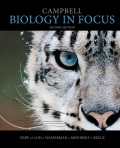
EBK CAMPBELL BIOLOGY IN FOCUS
2nd Edition
ISBN: 8220101459299
Author: Reece
Publisher: PEARSON
expand_more
expand_more
format_list_bulleted
Concept explainers
Textbook Question
Chapter 12, Problem 8TYU
Assume that genes A and B are 50 map units apart on the same chromosome. An animal heterozygous at both loci is crossed with one that is homozygous recessive at both loci. What percentage of the offspring will show recombinant
Expert Solution & Answer
Want to see the full answer?
Check out a sample textbook solution
Students have asked these similar questions
Other than oil and alcohol, are there other liquids you could compare to water (that are liquid at room temperature)?
How is water unique compared to these other liquids?
What follow-up experiment would you like to do, and how would you relate it to your life?
Selection of Traits
What adaptations do scavengers have for locating and feeding on prey?
What adaptations do predators have for capturing and consuming prey?
Competition Between Species
What natural processes limit populations from growing too large?
What are some resources organisms can compete over in their natural habitat?
Chapter 12 Solutions
EBK CAMPBELL BIOLOGY IN FOCUS
Ch. 12.1 - Which one of Mendels laws relates to the...Ch. 12.1 - MAKE CONNECTIONS Review the description of meiosis...Ch. 12.1 - WHAT IF? Propose a possible reason that the first...Ch. 12.2 - A white-eyed female Drosophila is mated with a...Ch. 12.2 - Neither Tim nor Rhoda has Duchenne muscular...Ch. 12.2 - MAKE CONNECTIONS Consider what you learned about...Ch. 12.3 - When two genes are located on the same chromosome,...Ch. 12.3 - For each type of offspring of the testcross in...Ch. 12.3 - WHAT IF? Genes A, B, and C are located on the same...Ch. 12.4 - About 5% of individuals with Down syndrome have a...
Ch. 12.4 - WHAT IF? The ABO blood type locus has been mapped...Ch. 12.4 - MAKE CONNECTIONS The gene that is activated on the...Ch. 12.4 - Women born with an extra X chromosome (XXX) are...Ch. 12 - A man with hemophilia (a recessive, sex-linked...Ch. 12 - Pseudohypertrophic muscular dystrophy is an...Ch. 12 - A space probe discovers a planet inhabited by...Ch. 12 - Using the information from problem 3, scientists...Ch. 12 - A man with red-green color blindness (a recessive,...Ch. 12 - You design Drosophila crosses to provide...Ch. 12 - A wild-type fruit fly (heterozygous for gray body...Ch. 12 - Assume that genes A and B are 50 map units apart...Ch. 12 - Prob. 9TYUCh. 12 - SCIENTIFIC INQUIRY DRAW IT Assume you are mapping...Ch. 12 - FOCUS ON EVOLUTION Crossing over is thought to be...Ch. 12 - FOCUS ON INFORMATION The continuity of life is...Ch. 12 - SYNTHESIZE YOUR KNOWLEDGE Butterflies have an X-Y...
Additional Science Textbook Solutions
Find more solutions based on key concepts
Single penny tossed 20 times and counting heads and tails: Probability (prediction): _______/20 heads ________/...
Laboratory Manual For Human Anatomy & Physiology
True or false? Some trails are considered vestigial because they existed long ago.
Biological Science (6th Edition)
Why do scientists think that all forms of life on earth have a common origin?
Genetics: From Genes to Genomes
Gregor Mendel never saw a gene, yet he concluded that some inherited factors were responsible for the patterns ...
Campbell Essential Biology (7th Edition)
Describe the role and impact of microbes on the earth.
Microbiology Fundamentals: A Clinical Approach
Knowledge Booster
Learn more about
Need a deep-dive on the concept behind this application? Look no further. Learn more about this topic, biology and related others by exploring similar questions and additional content below.Similar questions
- Species Interactions Explain how predators, prey and scavengers interact. Explain whether predators and scavengers are necessary or beneficial for an ecosystem.arrow_forwardmagine that you are conducting research on fruit type and seed dispersal. You submitted a paper to a peer-reviewed journal that addresses the factors that impact fruit type and seed dispersal mechanisms in plants of Central America. The editor of the journal communicates that your paper may be published if you make ‘minor revisions’ to the document. Describe two characteristics that you would expect in seeds that are dispersed by the wind. Contrast this with what you would expect for seeds that are gathered, buried or eaten by animals, and explain why they are different. (Editor’s note: Providing this information in your discussion will help readers to consider the significance of the research).arrow_forwardWhat is the difference between Uniporters, Symporters and Antiporters? Which of these are examples of active transport?arrow_forward
- What are Amyloid Fibrils? What biological functions are these known to perform?arrow_forwardHow do histamine and prostaglandins help in the mobilization of leukocytes to an injury site? What are chemotactic factors? How do they affect inflammation process?arrow_forwardCompare and contrast neutrophils and macrophages. Describe two ways they are different and two ways they are similar.arrow_forward
- Describe the effects of three cytokines (not involved in the initial inflammation response). What cells release them?arrow_forwardDescribe activation of helper T cells or cytotoxic T cellsarrow_forwardCompare and contrast MHC 1 and MHC 2. Describe two way they are different and two ways they similar including how they are used in antigen presentation.arrow_forward
arrow_back_ios
SEE MORE QUESTIONS
arrow_forward_ios
Recommended textbooks for you
 Biology (MindTap Course List)BiologyISBN:9781337392938Author:Eldra Solomon, Charles Martin, Diana W. Martin, Linda R. BergPublisher:Cengage Learning
Biology (MindTap Course List)BiologyISBN:9781337392938Author:Eldra Solomon, Charles Martin, Diana W. Martin, Linda R. BergPublisher:Cengage Learning

Biology (MindTap Course List)
Biology
ISBN:9781337392938
Author:Eldra Solomon, Charles Martin, Diana W. Martin, Linda R. Berg
Publisher:Cengage Learning
How to solve genetics probability problems; Author: Shomu's Biology;https://www.youtube.com/watch?v=R0yjfb1ooUs;License: Standard YouTube License, CC-BY
Beyond Mendelian Genetics: Complex Patterns of Inheritance; Author: Professor Dave Explains;https://www.youtube.com/watch?v=-EmvmBuK-B8;License: Standard YouTube License, CC-BY